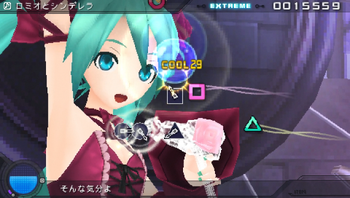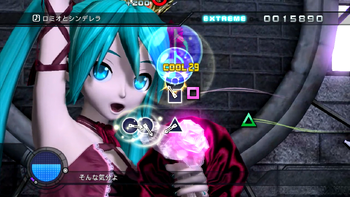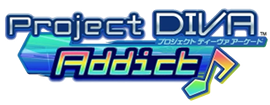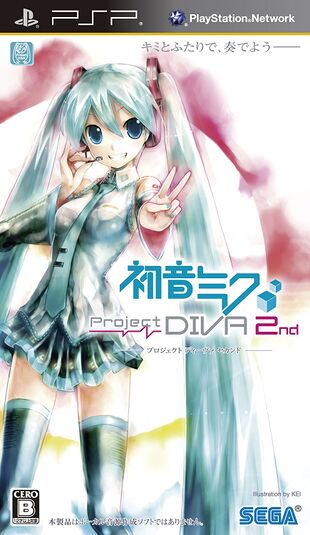Project DIVA 2nd: Difference between revisions
From Project DIVA Addict
m →Framerate: Updated copypasta from the PD1 |
m →Dreamy Theater 2nd: Capitalize DIVA |
||
| (4 intermediate revisions by the same user not shown) | |||
| Line 19: | Line 19: | ||
== Game Play == | == Game Play == | ||
Project | Project DIVA 2nd follows the game play of the original and introduces a few changes which became mainstays for the rest of the series. | ||
Of primary note is the use of the d-pad as a "second copy" of the trinagle/square/cross/circle buttons. This | Of primary note is the use of the d-pad as a "second copy" of the trinagle/square/cross/circle buttons. This change was added to allow players an easier way to make rapid buttons presses without having to akwardly position the PSP. Players can "dual-wield" by alternating between the face buttons and d-pad when the required input becomes too fast for a single thumb. | ||
Along with the introduction of the d-pad, Project Diva 2nd introduces "doubles" that requires players to press both the face button and corresponding d-pad direction together. The intent was for players to press these simultaneously, but the code that implements the functionality is "lazy" and allows the player to press and hold one input early and then press the second input at the correct time. For example, if the game wants cross+cross+double-cross, the player can prepare by holding cross or down in a "dead zone" ahead of time, and then just pressing the opposite button for the whole series. | Along with the introduction of the d-pad, Project Diva 2nd introduces "doubles" that requires players to press both the face button and corresponding d-pad direction together. Doubles are indicated with an arrow that has a W inside. The intent was for players to press these simultaneously, but the code that implements the functionality is "lazy" and allows the player to press and hold one input early and then press the second input at the correct time. For example, if the game wants cross+cross+double-cross, the player can prepare by holding cross or down in a "dead zone" ahead of time, and then just pressing the opposite button for the whole series. | ||
Along with doubles, Project DIVA 2nd also introduces "long" notes. Long notes have a "tail" and the player must press and hold the required button during the length of this tail, and let go at the end. | |||
The Extreme difficulty makes its first appearance in Project Diva 2nd, although in Project Diva 2nd the difficulty isn't as Extreme as songs would later become. | The Extreme difficulty makes its first appearance in Project Diva 2nd, although in Project Diva 2nd the difficulty isn't as Extreme as songs would later become. | ||
The difficulty rating scale has changed from 5 stars to 9 stars. | |||
Accuracy rating (COOL, FINE, etc.) is now displayed with the combo counter instead of being set off in the lower-right corner. | Accuracy rating (COOL, FINE, etc.) is now displayed with the combo counter instead of being set off in the lower-right corner. | ||
| Line 34: | Line 38: | ||
Achievement rating (STANDARD, GREAT, EXCELLENT) is now based on the percentage of notes that were successfully hit during play. Hitting 85% nets the player STANDARD, 95% gets the player GREAT, and 97%% is EXCELLENT. Note that game rounds percentage to the nearest whole numbers, so actual percentages are 84.5%, 94.5%, and 96.5% respectively. | Achievement rating (STANDARD, GREAT, EXCELLENT) is now based on the percentage of notes that were successfully hit during play. Hitting 85% nets the player STANDARD, 95% gets the player GREAT, and 97%% is EXCELLENT. Note that game rounds percentage to the nearest whole numbers, so actual percentages are 84.5%, 94.5%, and 96.5% respectively. | ||
==Framerate== | ==Framerate== | ||
| Line 47: | Line 47: | ||
Just as with the first game, Sega released Dreamy Theater 2nd on the PS3 as a companion to the PSP game. Of note, Dreamy Theater 2nd includes all of the songs from the original Dreamy Theater. This is most likely a "kiss and make up" to address the shortcomings of the original game engine. | Just as with the first game, Sega released Dreamy Theater 2nd on the PS3 as a companion to the PSP game. Of note, Dreamy Theater 2nd includes all of the songs from the original Dreamy Theater. This is most likely a "kiss and make up" to address the shortcomings of the original game engine. | ||
Dreamy Theater 2nd still requires a save file from the corresponding Project | Dreamy Theater 2nd still requires a save file from the corresponding Project DIVA 2nd on the PSP, which is still checked for via USB connection. However, this is only required once now. You only need to re-connect if you made further progress on the PSP and would like to update the PS3 version. | ||
Latest revision as of 19:41, 11 May 2022
| ||||||||


Hatsune Miku: Project DIVA 2nd is an sequel to the original game on PSP. It was released in 2010 with no plans for international release. And just like the first game, Sega also released Dreamy Theater 2nd which allowed players to play the songs on their PS3s.
Game Play
Project DIVA 2nd follows the game play of the original and introduces a few changes which became mainstays for the rest of the series.
Of primary note is the use of the d-pad as a "second copy" of the trinagle/square/cross/circle buttons. This change was added to allow players an easier way to make rapid buttons presses without having to akwardly position the PSP. Players can "dual-wield" by alternating between the face buttons and d-pad when the required input becomes too fast for a single thumb.
Along with the introduction of the d-pad, Project Diva 2nd introduces "doubles" that requires players to press both the face button and corresponding d-pad direction together. Doubles are indicated with an arrow that has a W inside. The intent was for players to press these simultaneously, but the code that implements the functionality is "lazy" and allows the player to press and hold one input early and then press the second input at the correct time. For example, if the game wants cross+cross+double-cross, the player can prepare by holding cross or down in a "dead zone" ahead of time, and then just pressing the opposite button for the whole series.
Along with doubles, Project DIVA 2nd also introduces "long" notes. Long notes have a "tail" and the player must press and hold the required button during the length of this tail, and let go at the end.
The Extreme difficulty makes its first appearance in Project Diva 2nd, although in Project Diva 2nd the difficulty isn't as Extreme as songs would later become.
The difficulty rating scale has changed from 5 stars to 9 stars.
Accuracy rating (COOL, FINE, etc.) is now displayed with the combo counter instead of being set off in the lower-right corner.
Scoring
Scoring remains the same as in the original game.
Achievement rating (STANDARD, GREAT, EXCELLENT) is now based on the percentage of notes that were successfully hit during play. Hitting 85% nets the player STANDARD, 95% gets the player GREAT, and 97%% is EXCELLENT. Note that game rounds percentage to the nearest whole numbers, so actual percentages are 84.5%, 94.5%, and 96.5% respectively.
Framerate
Sega made improvements to the game engine used on the PSP. Framerates remain above 20fps now, but can still dip low.
Dreamy Theater 2nd
Just as with the first game, Sega released Dreamy Theater 2nd on the PS3 as a companion to the PSP game. Of note, Dreamy Theater 2nd includes all of the songs from the original Dreamy Theater. This is most likely a "kiss and make up" to address the shortcomings of the original game engine.
Dreamy Theater 2nd still requires a save file from the corresponding Project DIVA 2nd on the PSP, which is still checked for via USB connection. However, this is only required once now. You only need to re-connect if you made further progress on the PSP and would like to update the PS3 version.

